Edge-Cloud Alarm Level of Heterogeneous IIoT Devices Based on Knowledge Distillation in Smart Manufacturing
Abstract
:1. Introduction
- To solve the bottleneck problem, we propose a cloud–fog–edge-distributed network that connects with heterogeneous devices in industrial sites that is based on a fog–edge, rather than a cloud-based, central control;
- We propose a knowledge distillation-based algorithm to efficiently apply deep-learning-based algorithms that require a lot of computing resources for the IIoT system;
- For detailed verification, we propose a soft-label-based alarm level to provide a smooth network connection and an accurate verification method for the algorithm.
2. Background and Related Work
2.1. Cloud–Fog–Edge Computing
2.2. Knowledge Distillation
2.3. Industrial Alarm Level
3. Cloud–Fog–Edge Alarm System Using Knowledge Distillation
3.1. Cloud–Fog–Edge Alarm-Level-Based Heterogeneous Device Knowledge Distillation
3.2. Soft-Label-Based Alarm Level
4. Experimental Environment
4.1. Dataset
4.2. Evaluation Metrics
5. Experiment and Result
5.1. CWRU Dataset
5.2. Casting Dataset
5.3. Experiment and Results
6. Conclusions
Author Contributions
Funding
Acknowledgments
Conflicts of Interest
References
- Stergiou, C.; Psannis, K.E.; Kim, B.G.; Gupta, B. Secure integration of IoT and cloud computing. Future Gener. Comput. Syst. 2018, 78, 964–975. [Google Scholar] [CrossRef]
- Gubbi, J.; Buyya, R.; Marusic, S.; Palaniswami, M. Internet of Things (IoT): A vision, architectural elements, and future directions. Future Gener. Comput. Syst. 2013, 29, 1645–1660. [Google Scholar] [CrossRef] [Green Version]
- Shafique, K.; Khawaja, B.A.; Sabir, F.; Qazi, S.; Mustaqim, M. Internet of things (IoT) for next-generation smart systems: A review of current challenges, future trends and prospects for emerging 5G-IoT scenarios. IEEE Access 2020, 8, 23022–23040. [Google Scholar] [CrossRef]
- Ahmed, E.; Yaqoob, I.; Gani, A.; Imran, M.; Guizani, M. Internet-of-things-based smart environments: State of the art, taxonomy, and open research challenges. IEEE Wirel. Commun. 2016, 23, 10–16. [Google Scholar] [CrossRef]
- Sadiku, M.N.; Musa, S.M.; Momoh, O.D. Cloud computing: Opportunities and challenges. IEEE Potentials 2014, 33, 34–36. [Google Scholar] [CrossRef]
- Dikaiakos, M.D.; Katsaros, D.; Mehra, P.; Pallis, G.; Vakali, A. Cloud computing: Distributed internet computing for IT and scientific research. IEEE Internet Comput. 2009, 13, 10–13. [Google Scholar] [CrossRef]
- Wang, L.; Von Laszewski, G.; Younge, A.; He, X.; Kunze, M.; Tao, J.; Fu, C. Cloud computing: A perspective study. New Gener. Comput. 2010, 28, 137–146. [Google Scholar] [CrossRef] [Green Version]
- Gomes, M.; da Rosa Righi, R.; da Costa, C.A. Internet of things scalability: Analyzing the bottlenecks and proposing alternatives. In Proceedings of the 2014 6th International Congress on Ultra Modern Telecommunications and Control Systems and Workshops (ICUMT), St. Petersburg, Russia, 6–8 October 2014; pp. 269–276. [Google Scholar]
- Jing, Q.; Vasilakos, A.V.; Wan, J.; Lu, J.; Qiu, D. Security of the Internet of Things: Perspectives and challenges. Wirel. Netw. 2014, 20, 2481–2501. [Google Scholar] [CrossRef]
- Efremov, S.; Pilipenko, N.; Voskov, L. An integrated approach to common problems in the Internet of Things. Procedia Eng. 2015, 100, 1215–1223. [Google Scholar] [CrossRef] [Green Version]
- Xingmei, X.; Jing, Z.; He, W. Research on the basic characteristics, the key technologies, the network architecture and security problems of the Internet of things. In Proceedings of the 2013 3rd International Conference on Computer Science and Network Technology, Dalian, China, 12–13 October 2013; pp. 825–828. [Google Scholar]
- Muneeb, M.; Ko, K.M.; Park, Y.H. A Fog Computing Architecture with Multi-Layer for Computing-Intensive IoT Applications. Appl. Sci. 2021, 11, 11585. [Google Scholar] [CrossRef]
- Xu, X.; Liu, Q.; Luo, Y.; Peng, K.; Zhang, X.; Meng, S.; Qi, L. A computation offloading method over big data for IoT-enabled cloud-edge computing. Future Gener. Comput. Syst. 2019, 95, 522–533. [Google Scholar] [CrossRef]
- Liu, D.; Chen, X.; Zhou, Z.; Ling, Q. HierTrain: Fast hierarchical edge AI learning with hybrid parallelism in mobile-edge-cloud computing. IEEE Open J. Commun. Soc. 2020, 1, 634–645. [Google Scholar] [CrossRef]
- Pham, V.N.; Lee, G.W.; Nguyen, V.; Huh, E.N. Efficient Solution for Large-Scale IoT Applications with Proactive Edge-Cloud Publish/Subscribe Brokers Clustering. Sensors 2021, 21, 8232. [Google Scholar] [CrossRef] [PubMed]
- Harmatos, J.; Maliosz, M. Architecture Integration of 5G Networks and Time-Sensitive Networking with Edge Computing for Smart Manufacturing. Electronics 2021, 10, 3085. [Google Scholar] [CrossRef]
- Yun, D.W.; Lee, W.C. Intelligent Dynamic Real-Time Spectrum Resource Management for Industrial IoT in Edge Computing. Sensors 2021, 21, 7902. [Google Scholar] [CrossRef]
- Wang, C.; Yang, G.; Papanastasiou, G.; Zhang, H.; Rodrigues, J.J.; de Albuquerque, V.H.C. Industrial cyber-physical systems-based cloud IoT edge for federated heterogeneous distillation. IEEE Trans. Ind. Inform. 2020, 17, 5511–5521. [Google Scholar] [CrossRef]
- Moreno-Vozmediano, R.; Montero, R.S.; Llorente, I.M. Iaas cloud architecture: From virtualized datacenters to federated cloud infrastructures. Computer 2012, 45, 65–72. [Google Scholar] [CrossRef]
- Jamsa, K. Cloud Computing: SaaS, PaaS, IaaS, Virtualization, Business Models, Mobile, Security and More; Jones & Bartlett Publishers: Burlington, MA, USA, 2012. [Google Scholar]
- Pahl, C. Containerization and the paas cloud. IEEE Cloud Comput. 2015, 2, 24–31. [Google Scholar] [CrossRef]
- Palos-Sanchez, P.R.; Arenas-Marquez, F.J.; Aguayo-Camacho, M. Cloud computing (SaaS) adoption as a strategic technology: Results of an empirical study. Mob. Inf. Syst. 2017, 2017, 2536040. [Google Scholar] [CrossRef] [Green Version]
- Saifuzzaman, M.; Shetu, S.F.; Moon, N.N.; Nur, F.N.; Ali, M.H. IoT Based Street Lighting Using Dual Axis Solar Tracker and Effective Traffic Management System Using Deep Learning: Bangladesh Context. In Proceedings of the 2020 11th International Conference on Computing, Communication and Networking Technologies (ICCCNT), Kharagpur, India, 1–3 July 2020; pp. 1–5. [Google Scholar]
- Hu, Y.C.; Patel, M.; Sabella, D.; Sprecher, N.; Young, V. Mobile edge computing—A key technology towards 5G. ETSI White Pap. 2015, 11, 1–16. [Google Scholar]
- Premsankar, G.; Di Francesco, M.; Taleb, T. Edge computing for the Internet of Things: A case study. IEEE Internet Things J. 2018, 5, 1275–1284. [Google Scholar] [CrossRef] [Green Version]
- Sun, X.; Ansari, N. EdgeIoT: Mobile edge computing for the Internet of Things. IEEE Commun. Mag. 2016, 54, 22–29. [Google Scholar] [CrossRef]
- Yi, S.; Li, C.; Li, Q. A survey of fog computing: Concepts, applications and issues. In Proceedings of the 2015 Workshop on Mobile Big Data, Hangzhou China, 21 June 2015; pp. 37–42. [Google Scholar]
- Bonomi, F.; Milito, R.; Zhu, J.; Addepalli, S. Fog computing and its role in the internet of things. In Proceedings of the first edition of the MCC workshop on Mobile cloud computing, Helsinki, Finland, 13–17 August 2012; pp. 13–16. [Google Scholar]
- Dastjerdi, A.V.; Gupta, H.; Calheiros, R.N.; Ghosh, S.K.; Buyya, R. Fog computing: Principles, architectures, and applications. In Internet of Things; Morgan Kaufmann Publishers: Burlington, MA, USA, 2016; pp. 61–75. [Google Scholar]
- Hinton, G.; Vinyals, O.; Dean, J. Distilling the knowledge in a neural network. arXiv 2015, arXiv:1503.02531. [Google Scholar]
- Wang, J.; Yang, F.; Chen, T.; Shah, S.L. An overview of industrial alarm systems: Main causes for alarm overloading, research status, and open problems. IEEE Trans. Autom. Sci. Eng. 2015, 13, 1045–1061. [Google Scholar] [CrossRef]
- Parsa, K.; Hassall, M.; Naderpour, M. Process Alarm Modeling Using Graph Theory: Alarm Design Review and Rationalization. IEEE Syst. J. 2020, 15, 2257–2268. [Google Scholar] [CrossRef]
- Al-Kharaz, M.; Ananou, B.; Ouladsine, M.; Combal, M.; Pinaton, J. Evaluation of alarm system performance and management in semiconductor manufacturing. In Proceedings of the 2019 6th International Conference on Control, Decision and Information Technologies (CoDIT), Paris, France, 23–26 April 2019; pp. 1155–1160. [Google Scholar]
- Shetu, S.F.; Saifuzzaman, M.; Moon, N.N.; Nur, F.N. A survey of Botnet in cyber security. In Proceedings of the 2019 2nd International Conference on Intelligent Communication and Computational Techniques (ICCT), Jaipur, India, 28–29 September 2019; pp. 174–177. [Google Scholar]
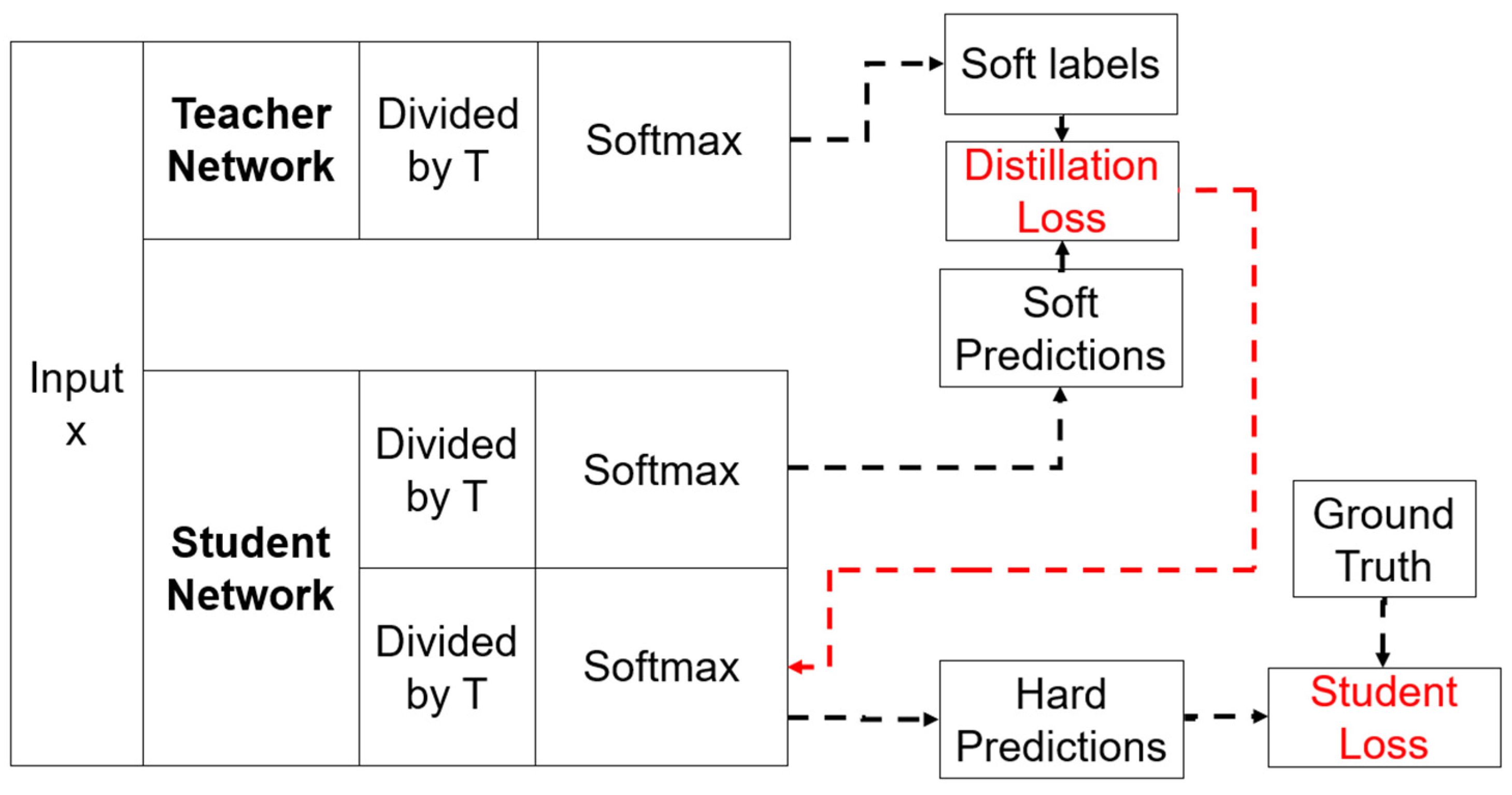

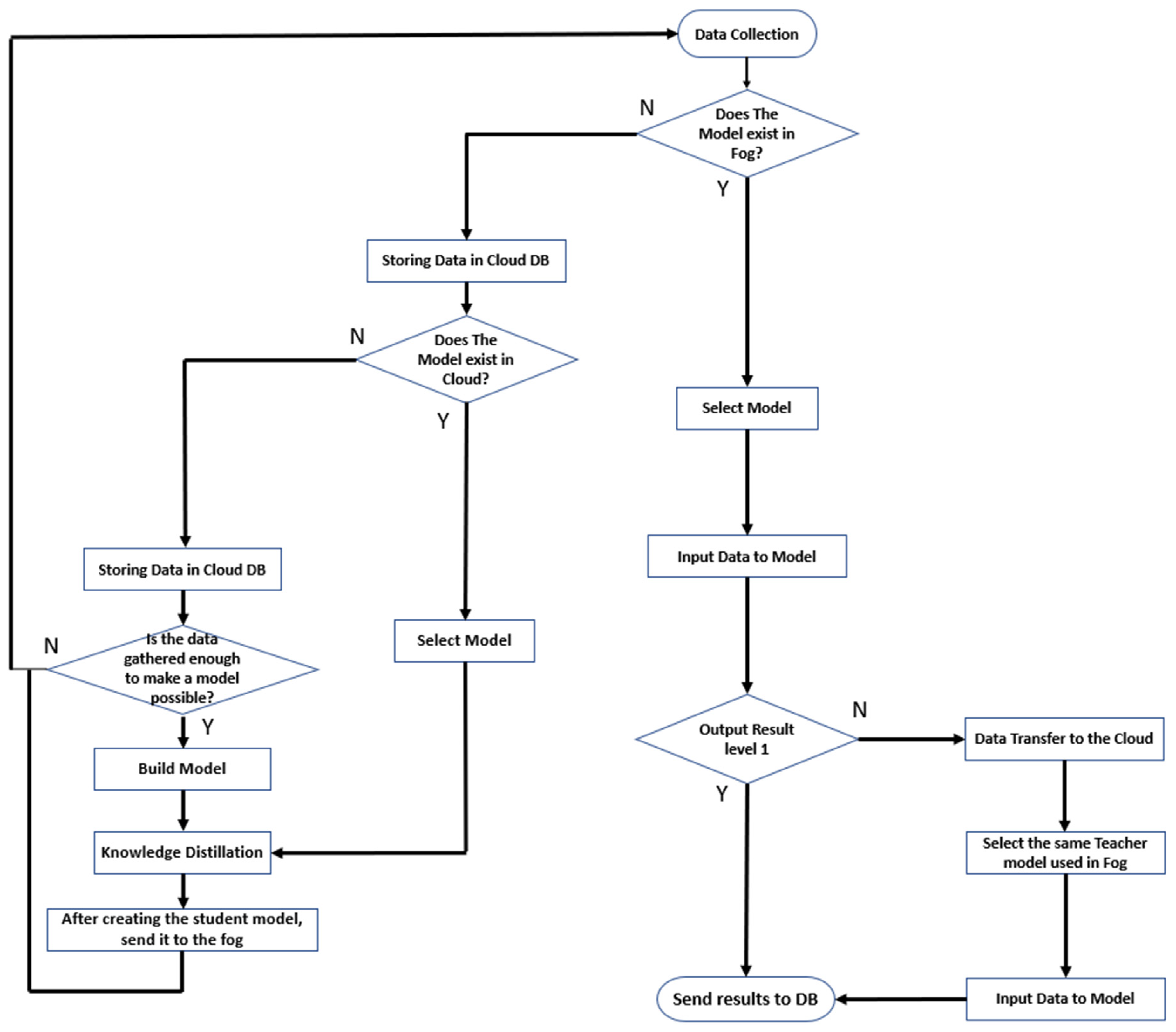
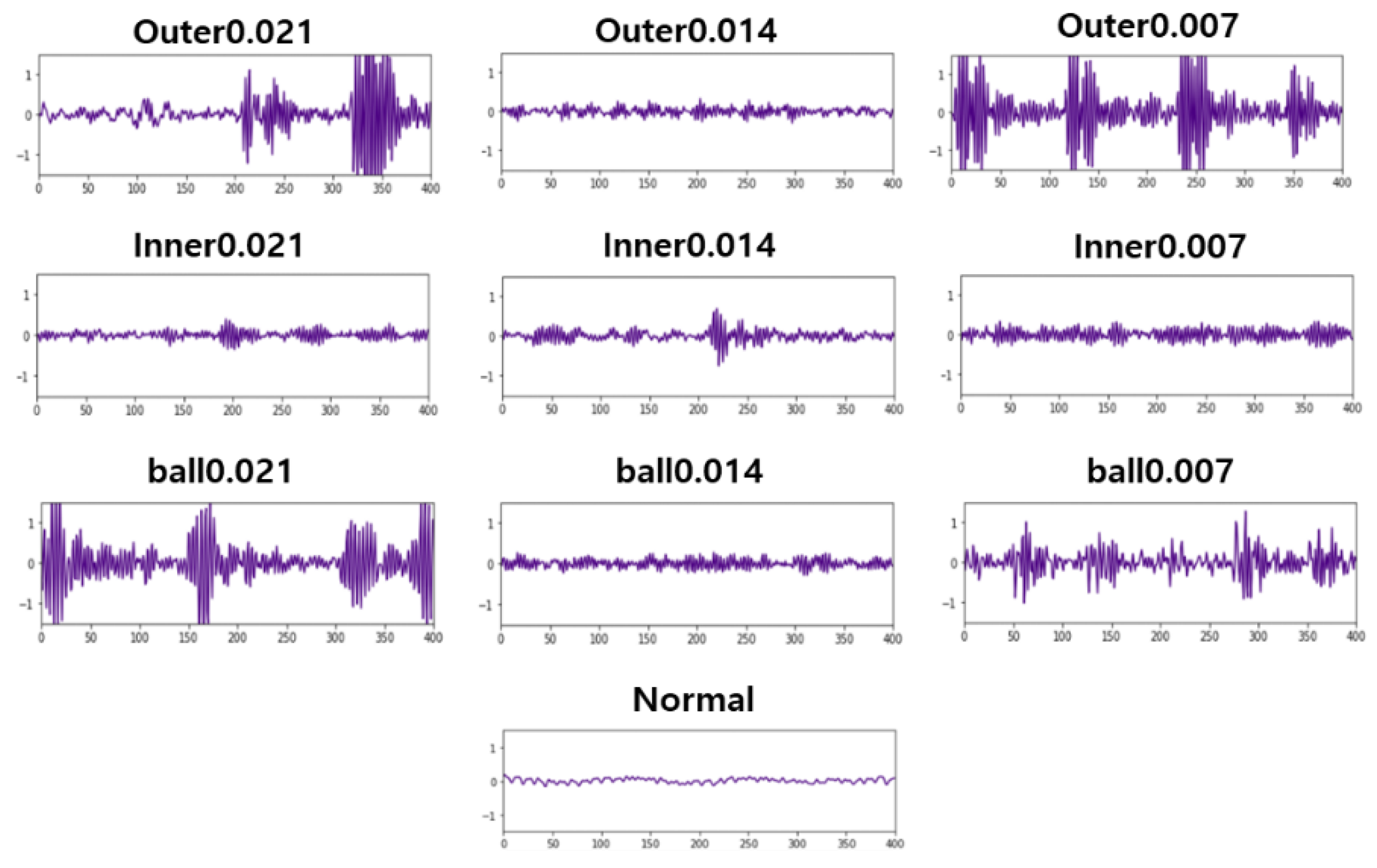

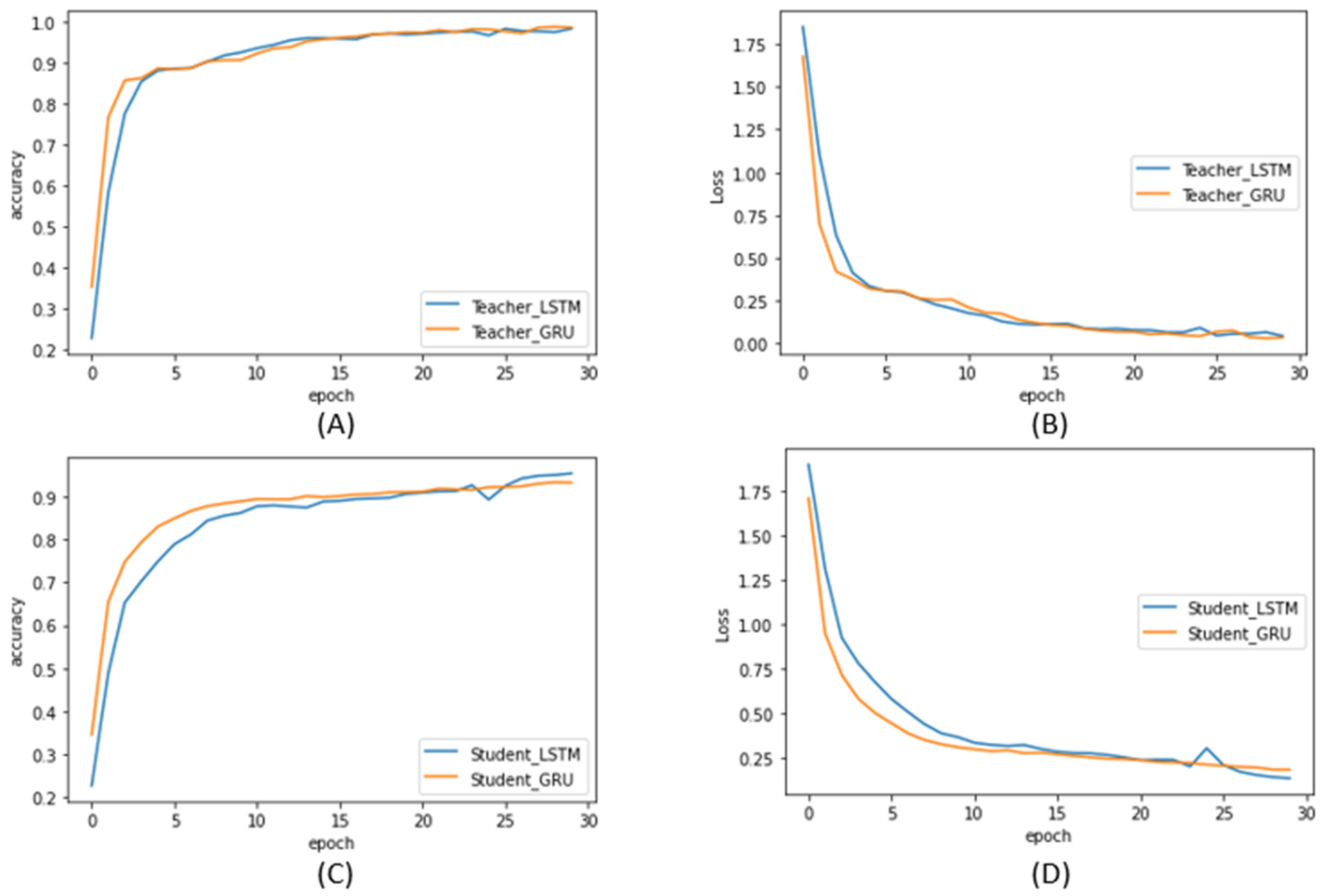
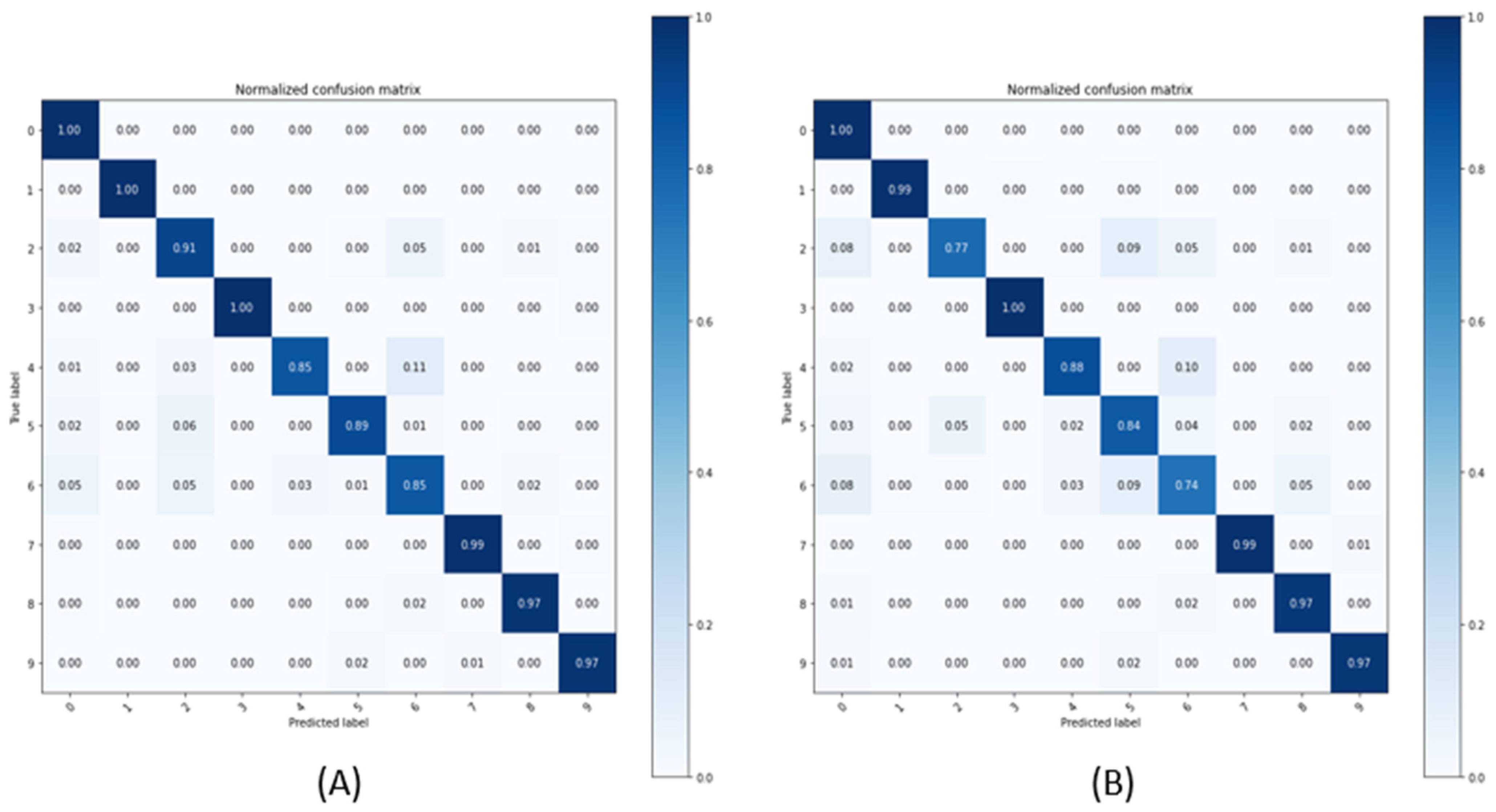
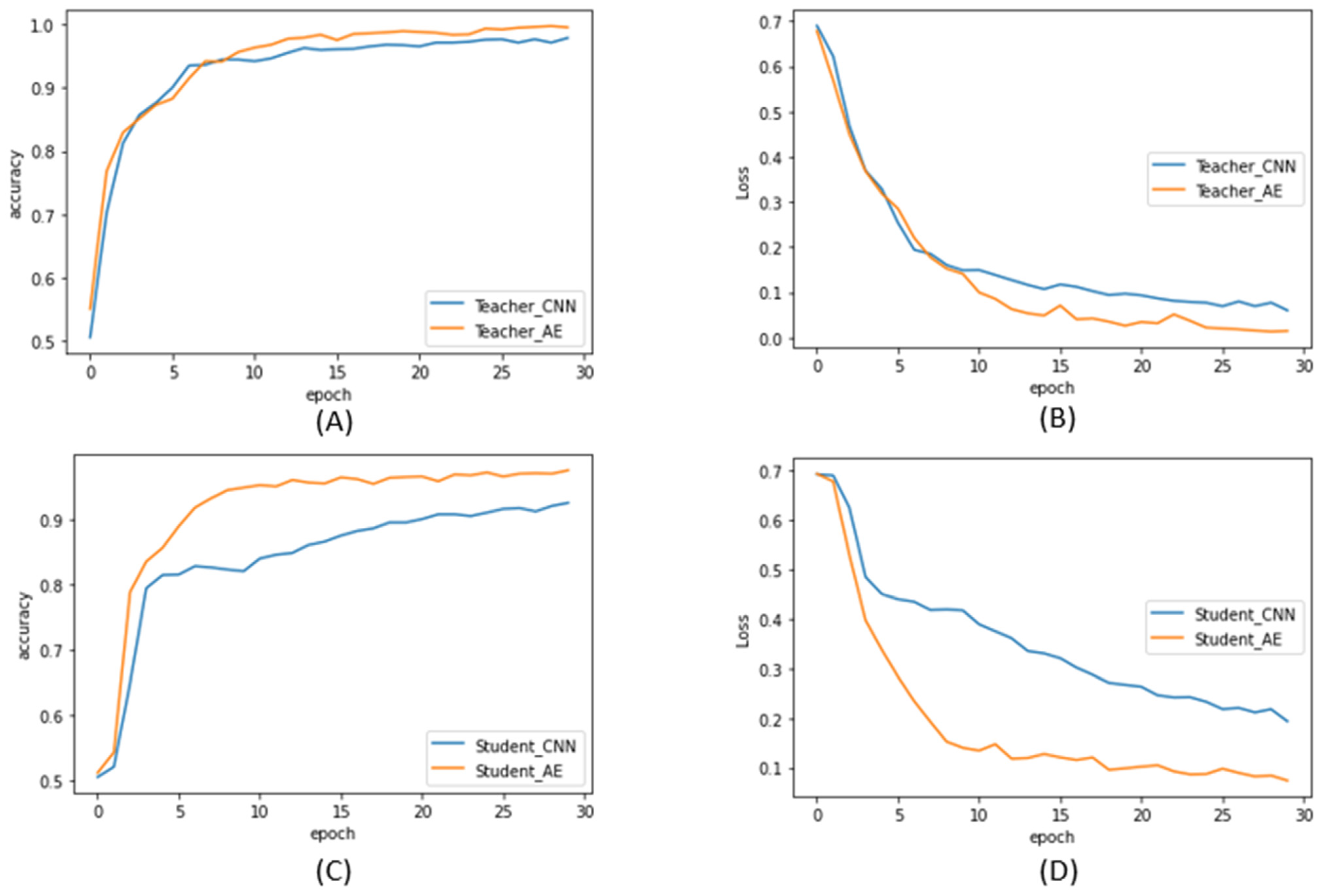

| Quantile | Range |
|---|---|
| Q1 | 0.705 |
| Q2 | 0.853 |
| Q3 | 0.901 |
| Q4 | 0.954 |
| Hardware Environment | Software Environment | |
|---|---|---|
| Cloud Computing | CPU: Intel Core i7-8700k, 3.7 Ghz, six-core twelve threads 16 GB GPU: Geforce RTX 2070 | Windows Tensorflow 2.0 Python 3.7 |
| Fog Computing | CPU: Intel Core i7-8700k, 3.7 Ghz, six-core twelve threads 16 GB | Windows Tensorflow 2.0 Python 3.7 |
| Edge Computing | CPU: four-core ARM A57 1.43 GHz 128 Core Maxwell 482 GFLOPs (FP16) | Linux Tensorflow 2.0 Python 3.6 |
| Model | ACC Top1 | F1-Score | MCC | |
|---|---|---|---|---|
| Teacher | LSTM | 97.81% | 96.32% | 95.87% |
| GRU | 95.52% | 93.72% | 93.22% | |
| Student | LSTM | 96.77% | 95.21% | 94.76% |
| GRU | 92.97% | 91.37% | 90.87% |
| Model | Level 1 (%) | Level 2 (%) | Level 3 (%) |
|---|---|---|---|
| Student (Fog) LSTM | 90 | 4 | 6 |
| Teacher (Cloud) LSTM | 96 | 2 | 2 |
| Student (Fog) GRU | 84 | 9 | 7 |
| Teacher (Cloud) GRU | 92 | 5 | 3 |
| Model | ACC Top1 | F1-Score | MCC | |
|---|---|---|---|---|
| Teacher | CNN | 94.79% | 93.39% | 92.91% |
| AE | 95.58% | 94.12% | 93.72% | |
| Student | CNN | 90.02% | 88.52% | 88.02% |
| AE | 93.92% | 92.47% | 92.05% |
| Model | Level 1 (%) | Level 2 (%) | Level 3 (%) |
|---|---|---|---|
| Student (Fog) AE | 88 | 2 | 10 |
| Teacher (Cloud) AE | 93 | 4 | 3 |
| Student (Fog) CNN | 68 | 5 | 27 |
| Teacher (Cloud) CNN | 91 | 3 | 6 |
| Model | ACC Top1 | F1-Score | MCC | |
|---|---|---|---|---|
| Teacher | LSTM | 97.81% | 96.32% | 95.87% |
| GRU | 95.52% | 93.72% | 93.22% | |
| AE | 95.58% | 94.12% | 93.72% | |
| CNN | 94.79% | 93.39% | 92.91% | |
| Student | LSTM | 96.77% | 95.21% | 94.76% |
| GRU | 92.97% | 91.37% | 90.87% | |
| AE | 93.92% | 92.47% | 92.05% | |
| CNN | 90.02% | 88.52% | 88.02% |
Publisher’s Note: MDPI stays neutral with regard to jurisdictional claims in published maps and institutional affiliations. |
© 2022 by the authors. Licensee MDPI, Basel, Switzerland. This article is an open access article distributed under the terms and conditions of the Creative Commons Attribution (CC BY) license (https://creativecommons.org/licenses/by/4.0/).
Share and Cite
Oh, S.; Kim, D.; Lee, C.; Jeong, J. Edge-Cloud Alarm Level of Heterogeneous IIoT Devices Based on Knowledge Distillation in Smart Manufacturing. Electronics 2022, 11, 899. https://doi.org/10.3390/electronics11060899
Oh S, Kim D, Lee C, Jeong J. Edge-Cloud Alarm Level of Heterogeneous IIoT Devices Based on Knowledge Distillation in Smart Manufacturing. Electronics. 2022; 11(6):899. https://doi.org/10.3390/electronics11060899
Chicago/Turabian StyleOh, Seokju, Donghyun Kim, Chaegyu Lee, and Jongpil Jeong. 2022. "Edge-Cloud Alarm Level of Heterogeneous IIoT Devices Based on Knowledge Distillation in Smart Manufacturing" Electronics 11, no. 6: 899. https://doi.org/10.3390/electronics11060899
APA StyleOh, S., Kim, D., Lee, C., & Jeong, J. (2022). Edge-Cloud Alarm Level of Heterogeneous IIoT Devices Based on Knowledge Distillation in Smart Manufacturing. Electronics, 11(6), 899. https://doi.org/10.3390/electronics11060899







